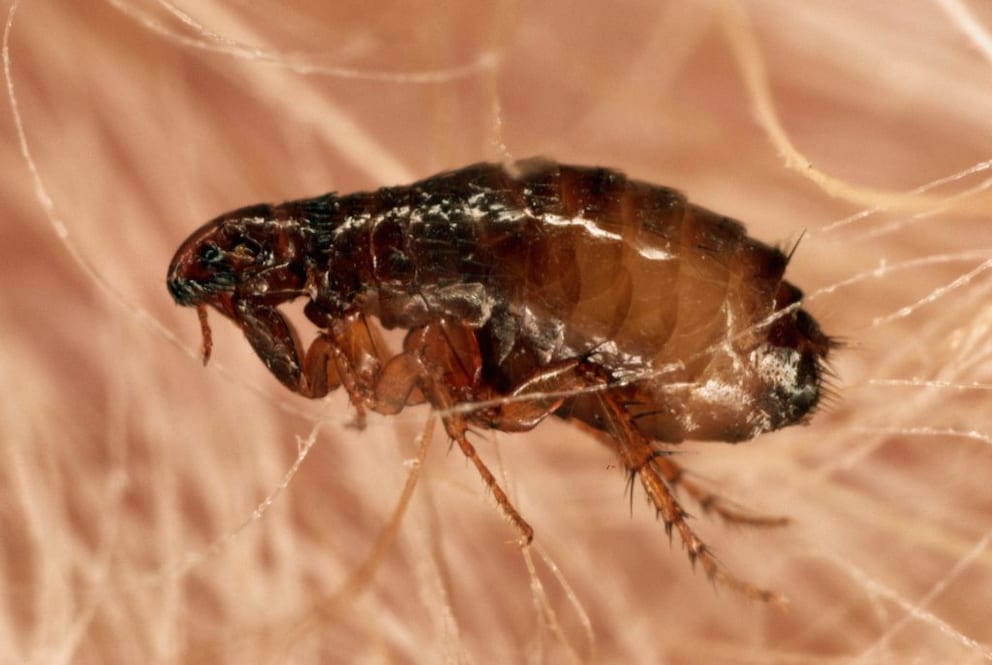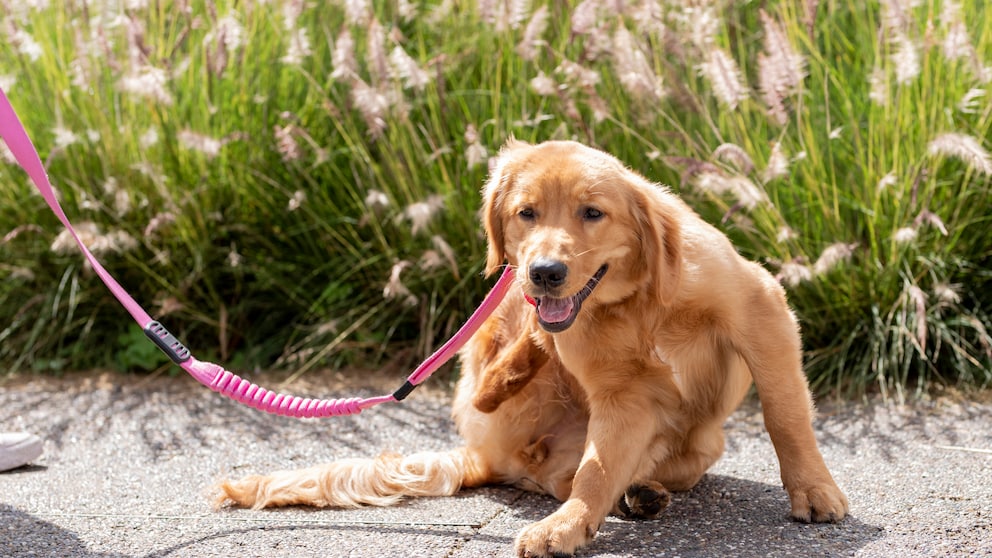April 11, 2025, 9:06 am | Read time: 5 minutes
If dogs suddenly start scratching or licking themselves more often, there may be more to it than just a harmless itch. A flea infestation can be life-threatening, especially in puppies — because tiny bloodsuckers can have serious consequences. But how can you recognize fleas and reliably get rid of them?
Fleas are a nuisance for dogs, but for puppies, a flea infestation can be particularly dangerous. If the parasites excessively feed on the young dog’s blood, it can lead to anemia. PETBOOK explains the symptoms fleas cause in dogs and the measures you can take against these pests.
Overview
How Can I Tell If My Dog Has Fleas?
If your dog scratches, nibbles, and licks itchy areas conspicuously often, this could indicate a flea infestation. You should then check your dog’s coat and skin for signs of fleas. The easiest way to do this is with a special flea comb: the animal’s hair is carefully combed out, preferably behind the ears, along the spine, and at the root of the tail.1

If black granules become lodged in the comb’s teeth, these could be flea feces. Slightly dampen these particles and press them between layers of a paper towel. If the black dots change to a brownish-red hue, it’s a strong indication they are flea feces, which contain digested blood from your dog. Additional indicators of flea presence in dogs include bald spots in the fur, skin redness, and crusty lesions. Sometimes, the pests themselves can be seen with the naked eye. 2 3
What Is the Best Way to Treat Fleas on Dogs?
There are various flea remedies to effectively combat the bloodsuckers. In most cases, so-called spot-on preparations are used, which are applied to the animal’s neck and spread over the entire dog’s body from there. However, sprays, tablets, and special flea collars are also available. If you are unsure about how to use them, contact your vet. They will provide you with all the important information. The veterinarian may also suggest concurrent deworming since fleas can carry and transmit the cucumber tapeworm. 4
The Environment Must Also Be Treated
What many people don’t know: Only about five percent of the flea population lives directly on the animal. The majority, which includes eggs, larvae, and pupae, is present in the environment. Thorough cleaning is, therefore, a must in the event of an infestation.
Blankets and stuffed animals can be washed in the washing machine at 60 degrees Celsius. Alternatively, you can put them in the freezer for at least ten days. Upholstered furniture, car seats, and carpets should be vacuumed multiple times, and crevices and smooth floors need thorough cleaning.
Important: When using environmental sprays with flea products, all animals, including aquariums and terrariums, must be removed from the room beforehand. Following the recommended exposure time, ventilate the room thoroughly before allowing people and animals to re-enter.
How Long Does It Take to Get Rid of Fleas on Dogs?
Flea infestations can be persistent. The larvae and pupae of the small insects, in particular, can go for months without food. Treatment must, therefore, always be consistent and long-term. Successfully eliminating fleas requires treating all animals in the household as well as the environment. It usually takes two to four months before a dog is completely flea-free again.
Good to know: Dog and cat fleas can also infest humans. Typical symptoms are unpleasant itching, red spots on the skin, and pustules. The redness often occurs in a row, the so-called flea bite chain. If your dog is susceptible to fleas or develops an allergic reaction to flea infestation, flea prophylaxis may be advisable. Flea medication can also be used preventatively.
How to Effectively Prevent Flea Infestations
Rather than reacting after the dog starts scratching and the infestation of larvae, eggs, and fleas has spread, proactive measures should be taken to prevent infestations early on. The risk increases especially after walks in the countryside. Many tick repellents also prevent flea infestations. It is best to seek advice from your vet. Spot-on preparations or flea collars are most commonly used.
Caution: Some flea control products suitable for dogs can be life-threatening for cats because they have a different metabolism. If cats also live in the household, you should avoid close physical contact between the dog and cat for some time after applying the preparation. Preferably, opt for products that are safe for both dogs and cats.

Recognizing and Treating Lungworm Infestation in Cats

Can You Simply Dispose of Veterinary Medicines in the Trash?

Feline zoonoses: Cats can transmit these diseases to humans
What Are the Benefits of Oils, Amber Necklaces, and the Like?
To combat and prevent fleas, products are advertised time and time again or even touted as miracle cures that rely on natural active ingredients instead of “nasty chemicals.” Often, these are essential oils, which can be effective against the parasites when applied directly, but when used as the sole active ingredient in a flea collar, they may not provide adequate prevention. There is still no scientific evidence for the effect of amber chains against fleas or ticks.

